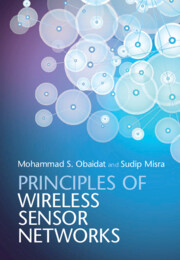Book contents
- Frontmatter
- Dedication
- Contents
- Preface
- 1 Introduction to wireless sensor networks
- 2 Inside a wireless sensor node: structure and operations
- 3 Wireless sensor network applications: overview and case studies
- 4 Medium access in wireless sensor networks
- 5 Routing in wireless sensor networks
- 6 Transport protocols for wireless sensor networks
- 7 Localization and tracking
- 8 Topology management and control
- 9 Performance evaluation of wireless sensor networks
- 10 Security issues in wireless sensor networks
- 11 Wireless mobile sensor networks
- 12 Wireless multimedia sensor networks
- 13 Underwater sensor networks
- 14 Wireless underground sensor networks
- References
- Subject index
- References
9 - Performance evaluation of wireless sensor networks
Published online by Cambridge University Press: 05 December 2014
- Frontmatter
- Dedication
- Contents
- Preface
- 1 Introduction to wireless sensor networks
- 2 Inside a wireless sensor node: structure and operations
- 3 Wireless sensor network applications: overview and case studies
- 4 Medium access in wireless sensor networks
- 5 Routing in wireless sensor networks
- 6 Transport protocols for wireless sensor networks
- 7 Localization and tracking
- 8 Topology management and control
- 9 Performance evaluation of wireless sensor networks
- 10 Security issues in wireless sensor networks
- 11 Wireless mobile sensor networks
- 12 Wireless multimedia sensor networks
- 13 Underwater sensor networks
- 14 Wireless underground sensor networks
- References
- Subject index
- References
Summary
Performance evaluation of Wireless Sensor Networks (WSNs), like any communications network system, can be conducted by using simulation analysis, analytic modeling, and measurement/testing techniques. Evaluation of WSN systems is needed at every stage in their life. There is no point in designing and implementing a new system that does not have competitive performance, and does not meet the objectives and performance evaluation and quality of service requirements. Performance evaluation of an existing system is also important since it helps to determine how well it is performing and whether any improvements are needed in order to enhance the performance [1].
After a system has been built and is running, its performance can be assessed by using the measurement technique. In order to evaluate the performance of a component or subsystem that cannot be measured, for example, during the design and development phases, it is necessary to use analytic and/or simulation modeling so as to predict the performance [1–46].
The objective of this chapter is to provide an up-to-date treatment of the techniques that can be used to evaluate the performance of WSN systems.
Background information
Wireless sensor networks (WSNs) are unique in certain aspects that make them different from other wireless networks. These aspects include:
- Type
- Chapter
- Information
- Principles of Wireless Sensor Networks , pp. 200 - 221Publisher: Cambridge University PressPrint publication year: 2014



